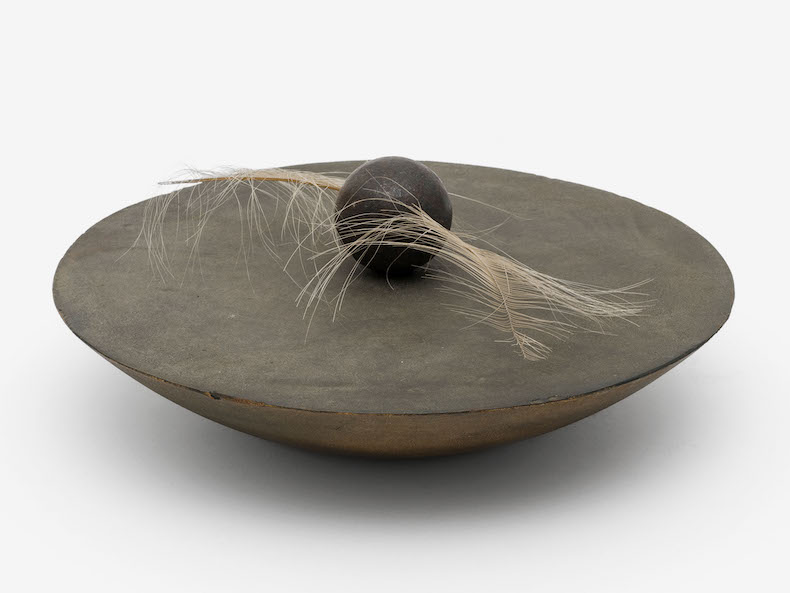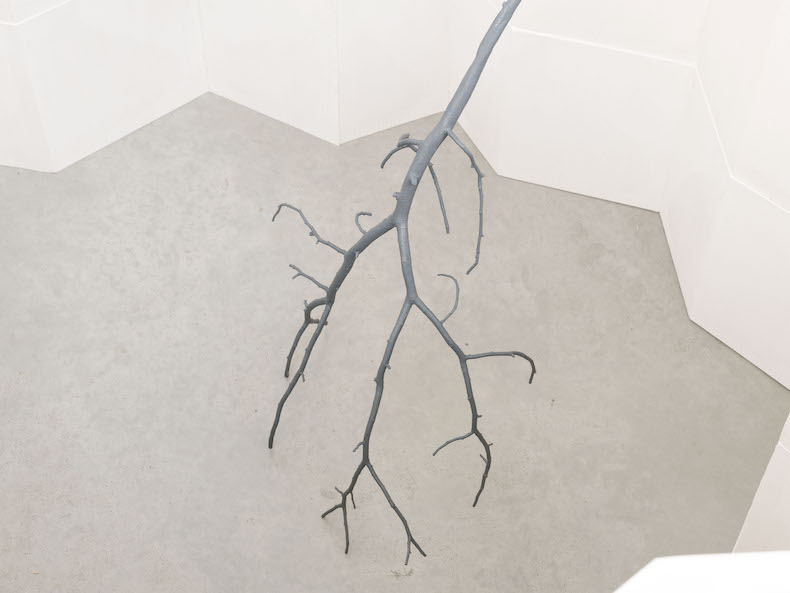
How Alison Wilding pushes materials to their limits
In 1975, Alison Wilding created Without Casting Light on the Subject. The sculptural installation featured two blacked-out reading lamps, one placed on top of a table, the other beneath it, and pointed to an innate tension between materials. Obstructed by the table and their own light-proof coverings, the lamps were unable to illuminate the glass and slate sheets that rested on the table’s surface; object and viewer were destined to remain in the dark.
The installation, long-since destroyed by its maker, lives on through a framed black-and-white photograph and a written description, which form a new work named after the old one. Wilding’s idiosyncratic approach to materials is to the fore in ‘Testing the Objects of Affection’, a small but scintillating display of sculptures from the last five decades, at Alison Jacques Gallery. In Wilding’s work, what you see is what you get. Aside from the relic of Without Casting Light on the Subject and a similar piece describing another dismantled work, there are no wall texts or labels. Viewers must look at her constructions and draw their own conclusions.
Without Casting Light on the Subject (1975), Alison Wilding. Photo: Michael Brzezinski; courtesy Alison Jacques, London; © Alison Wilding
The first sculptures in the exhibition are small-scale works arranged on a table from the artist’s London studio. At first glance, Press 1 and Press 2 (both 2006) appear to be cubes of rosy alabaster, but closer inspection reveals a thin sheet of paper sandwiched between spliced segments of stone. On a parallel wall, Ahem (2020) is an oblong form, also carved from alabaster, and crowned with matte black high-density foam. These unexpected combinations of materials are a signature move by Wilding, in whose work hard surfaces meet soft ones, found objects are paired with the artist’s own careful creations and cheap materials mingle with expensive ones.
For Wilding, no single material reigns supreme and the artist has said that she rarely knows how a work is going to turn out. This attitude reflects her association with the New British Sculpture movement, which, in the 1980s, pushed back against the conceptual art of earlier decades in favour of a simpler, more direct approach to materials. It was during this period that Wilding’s work began receiving more attention; she was nominated twice for the Turner Prize, in 1988 and 1992.

Killjoy (2015), Alison Wilding. Photo: Michael Brzezinski; courtesy Alison Jacques, London; © Alison Wilding
Elsewhere at Alison Jacques, Wilding’s experiments with the push and pull of materials sprawl from table to floor. In Trip Trap (2023), two long sheets of black rubber are laid flat on the ground and topped with a small, scrappy iron form and a smooth, egg-like dome. Nearby, Belvedere (2011) echoes this juxtaposition of contrasting materials: a fibreglass balloon is attached to the end of a branch made from bronze and rests on the walls of a plaster and jesmonite enclosure. These representational elements, scarce in Wilding’s work, bring a sense of containment; the balloon and twisting tree are trapped within their angled confines.
In the gallery’s brightly lit back room, further contrasts are made between light and shadow, balance and instability. In Drowned (1993), the core of a towering, translucent cone of deep green acrylic is almost imperceptible, but catch the sculpture at just the right angle and it hints at something metal and weighty within. Terrestrial (2003) is one of Wilding’s signature monocoque sculptures, a self-supporting construction of grids of smoky plastic. Made some 25 years after Without Casting a Light on the Subject, Terrestrial shows a similar interest in concealment, its shape reminiscent of two stealth bombers.

Installation view of Belvedere (2011) by Alison Wilding in ‘Alison Wilding: Testing the Objects of Affection’, Photo: Michael Brzezinski; courtesy Alison Jacques, London; © Alison Wilding
Things teeter precariously in the Tablet series (2009), in which four Crystacal plaster rectangles brushed with wood ash sit at the very edge of bronze wall plinths. Peering behind them reveals a gap between the plaster works and the wall, seemingly wide enough that a wrong move could send them tumbling. Likewise, Hocus Pocus (2022) balances a twisted metal ball on a narrow, curving form with serrated edges, ready to roll to the floor at any moment. It’s by creating tensions like these that Wilding has kept audiences on their toes for the past 50 years, as she upends our expectations of how a material should look and behave to offer what she calls ‘a glimpse of an alternative order’.
‘Alison Wilding: Testing the Objects of Affection’ is at Alison Jacques, London, until 28 October.